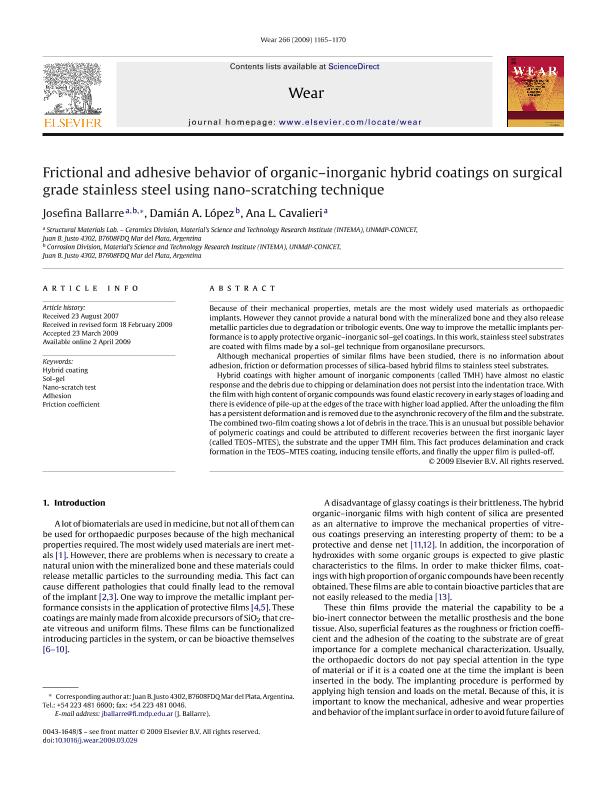Mostrar el registro sencillo del ítem
dc.contributor.author
Ballarre, Josefina

dc.contributor.author
López, Damián A.
dc.contributor.author
Cavalieri, Ana Lia

dc.date.available
2018-12-12T20:53:53Z
dc.date.issued
2009-05
dc.identifier.citation
Ballarre, Josefina; López, Damián A.; Cavalieri, Ana Lia; Frictional and adhesive behavior of organic-inorganic hybrid coatings on surgical grade stainless steel using nano-scratching technique; Elsevier Science Sa; Wear; 266; 11-12; 5-2009; 1165-1170
dc.identifier.issn
0043-1648
dc.identifier.uri
http://hdl.handle.net/11336/66387
dc.description.abstract
Because of their mechanical properties, metals are the most widely used materials as orthopaedic implants. However they cannot provide a natural bond with the mineralized bone and they also release metallic particles due to degradation or tribologic events. One way to improve the metallic implants performance is to apply protective organic-inorganic sol-gel coatings. In this work, stainless steel substrates are coated with films made by a sol-gel technique from organosilane precursors. Although mechanical properties of similar films have been studied, there is no information about adhesion, friction or deformation processes of silica-based hybrid films to stainless steel substrates. Hybrid coatings with higher amount of inorganic components (called TMH) have almost no elastic response and the debris due to chipping or delamination does not persist into the indentation trace. With the film with high content of organic compounds was found elastic recovery in early stages of loading and there is evidence of pile-up at the edges of the trace with higher load applied. After the unloading the film has a persistent deformation and is removed due to the asynchronic recovery of the film and the substrate. The combined two-film coating shows a lot of debris in the trace. This is an unusual but possible behavior of polymeric coatings and could be attributed to different recoveries between the first inorganic layer (called TEOS-MTES), the substrate and the upper TMH film. This fact produces delamination and crack formation in the TEOS-MTES coating, inducing tensile efforts, and finally the upper film is pulled-off. © 2009 Elsevier B.V. All rights reserved.
dc.format
application/pdf
dc.language.iso
eng
dc.publisher
Elsevier Science Sa

dc.rights
info:eu-repo/semantics/openAccess
dc.rights.uri
https://creativecommons.org/licenses/by-nc-sa/2.5/ar/
dc.subject
Adhesion
dc.subject
Friction Coefficient
dc.subject
Hybrid Coating
dc.subject
Nano-Scratch Test
dc.subject
Sol-Gel
dc.subject.classification
Química Orgánica

dc.subject.classification
Ciencias Químicas

dc.subject.classification
CIENCIAS NATURALES Y EXACTAS

dc.title
Frictional and adhesive behavior of organic-inorganic hybrid coatings on surgical grade stainless steel using nano-scratching technique
dc.type
info:eu-repo/semantics/article
dc.type
info:ar-repo/semantics/artículo
dc.type
info:eu-repo/semantics/publishedVersion
dc.date.updated
2018-12-05T14:38:01Z
dc.journal.volume
266
dc.journal.number
11-12
dc.journal.pagination
1165-1170
dc.journal.pais
Países Bajos

dc.journal.ciudad
Amsterdam
dc.description.fil
Fil: Ballarre, Josefina. Consejo Nacional de Investigaciones Científicas y Técnicas. Centro Científico Tecnológico Conicet - Mar del Plata. Instituto de Investigaciones en Ciencia y Tecnología de Materiales. Universidad Nacional de Mar del Plata. Facultad de Ingeniería. Instituto de Investigaciones en Ciencia y Tecnología de Materiales; Argentina
dc.description.fil
Fil: López, Damián A.. Consejo Nacional de Investigaciones Científicas y Técnicas. Centro Científico Tecnológico Conicet - Mar del Plata. Instituto de Investigaciones en Ciencia y Tecnología de Materiales. Universidad Nacional de Mar del Plata. Facultad de Ingeniería. Instituto de Investigaciones en Ciencia y Tecnología de Materiales; Argentina
dc.description.fil
Fil: Cavalieri, Ana Lia. Consejo Nacional de Investigaciones Científicas y Técnicas. Centro Científico Tecnológico Conicet - Mar del Plata. Instituto de Investigaciones en Ciencia y Tecnología de Materiales. Universidad Nacional de Mar del Plata. Facultad de Ingeniería. Instituto de Investigaciones en Ciencia y Tecnología de Materiales; Argentina
dc.journal.title
Wear

dc.relation.alternativeid
info:eu-repo/semantics/altIdentifier/doi/https://dx.doi.org/10.1016/j.wear.2009.03.029
dc.relation.alternativeid
info:eu-repo/semantics/altIdentifier/url/https://www.sciencedirect.com/science/article/pii/S0043164809002944
Archivos asociados
